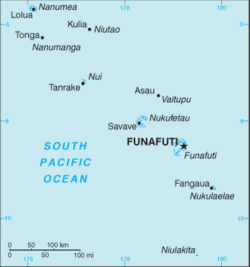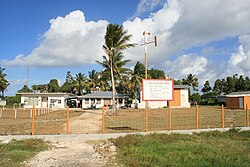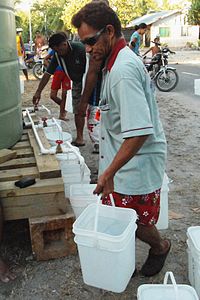
The 2011 Tuvalu drought was a period of severe drought afflicting Tuvalu, a South Pacific island country of approximately 10,500 people, in the latter half of 2011. A state of emergency was declared on September 28, 2011; with rationing of available fresh-water. The La Niña event that caused the drought ended in April–May 2012. By August 2012 the El Niño-Southern Oscillation (ENSO) Conditions indicated that the tropical Pacific Ocean was on the brink of an El Niño event.
Background
Tuvalu experiences the effects of El Niño & La Niña that flow from changes in ocean temperatures in equatorial and central Pacific. El Niño effects increase the chances of tropical cyclones; while La Niña effects increase the chances of drought conditions in Tuvalu.
Tuvalu relies primarily on rainfall for the majority of its drinking water, which is collected and stored in storage tanks. The country normally receives between 200–400 mm (7.87–15.75 in) of rain per month during an average year.
La Niña effect and drought

The country had been hit by a prolonged period of dry weather in the second half 2011, which had been attributed to the La Niña that results in the cooling of the surface temperature of the sea around Tuvalu which resulted in reduced rainfall. In October 2011, the Tuvalu Red Cross reported that the country had not received normal rainfall in six months, leading to shortages. The capital, Funafuti, and several of the outer atolls had been particularly affected by the drought. Nukulaelae and Nanumaga were the most seriously affected outer islands. The dry conditions on Nukulaelae affected the vast majority of pulaka pits - Pulaka, or swamp taro, is a staple crop for Tuvaluans. On Vaitupu the drought was also severe, but not as bad as the other islands.
Declaration of a state of emergency
The government declared a state of emergency on September 28, 2011, due to severe water shortages in the capital atoll, Funafuti. The drought conditions resulted in water being rationed on the islands of Funafuti and Nukulaelae as water reserves ran low. Households on Funafuti and Nukulaelae were restricted to two buckets of fresh water per day (40 litres).
Households on Funafuti and Nukulaelae were rationed to two buckets of fresh-water a day (40 litres). A resident of Funafuti (in a household of 5 people) is quoted as saying that it is "hard, very hard" for her household to get by on the ration of two buckets of water a day. Meanwhile, other Tuvaluans were being forced to pay for imported foods as the consequence of failing crops as the result of the drought. Princess Margaret Hospital limited admissions to try and cope with the water rationing, with a fear that there may be a rise in waterborne diseases due to a lack of public bathing.
The secretary general of Tuvalu Red Cross, Tataua Pefe, said that lack of rain had caused the contamination of remaining ground water supplies, "It's not safe for consumption...Some animals have died recently and we think it's because of subterranean water."
Lack of rainfall had affected other countries and territories in the region, including American Samoa, Samoa, Tokelau and Tonga.
International aid

New Zealand began airlifting supplies and fresh water to Tuvalu on Monday, October 3, 2011. The New Zealand government had received reports during the prior weekend that parts of Tuvalu had just a two-day supply of water left, according to Foreign Affairs Minister Murray McCully. A New Zealand Air Force C-130 Hercules transport plane landed in the country carrying two desalination units and large containers of fresh water into Funafuti. Australia also sent a desalination plant.
Officials from various aid agencies, including the International Red Cross and the Tuvalu Red Cross, worked with the New Zealand and Tuvaluan governments to alleviate the drought and shortages.
The government of South Korea funded the shipment of 60,000 bottles of water from Fiji to Tuvalu. The governments of Australia and New Zealand responded to the fresh-water crisis by supplying temporary desalination plants, and assisting in the repair of the existing desalination unit that was donated by Japan in 2006.
In response to the 2011 drought, Japan funded the purchase of a 100 m³/d desalination plant and two portable 10 m³/d plants as part of its Pacific Environment Community (PEC) program. Tuvalu had previously purchased a desalination plant from Japan during the 1999 drought.
Aid programmes of the European Union in 2010 and 2011; and Australia also provided water storage tanks to increase storage capacity in the outer islands as part of a longer term solution for the storage of available fresh water. Australia has also funded the installation of water tanks on Funafuti, which project also involved improving roof and gutter systems of households to capture more fresh water. In July 2012 a United Nations Special Rapporteur called on the Tuvalu Government to develop a national water strategy to improve access to safe drinking water and sanitation.
See also
References
- ^ "Tuvalu: state of emergency declared over water shortages". The Daily Telegraph. 2011-10-03. Retrieved 2011-10-02.
- ^ Benns, Matthew (2011-10-03). "Tuvalu 'to run out of water by Tuesday'". The Daily Telegraph. Retrieved 2011-10-03.
- ^ Vula, Timoci (2011-10-06). "Serious' on Tuvalu". Fiji Times. Archived from the original on 2012-07-30. Retrieved 2011-10-06.
- Boland, Steve (13 October 2011). "Tuvalu Water Crisis: Photos from Funafuti". Archived from the original on October 18, 2011. Retrieved 14 Oct 2011.
- "Island Climate Update 140 - May 2012". NIWA, the National Institute of Water and Atmospheric Research of New Zealand. 15 May 2012. Retrieved 15 August 2012.
- "Island Climate Update 143 - August 2012". NIWA, the National Institute of Water and Atmospheric Research of New Zealand. 3 August 2012. Retrieved 15 August 2012.
- "El Niño and La Niña". Australian Government Bureau of Meteorology. Archived from the original on 2011-12-14. Retrieved 9 Oct 2011.
- P A Kingston, 2004. Surveillance of Drinking Water Quality in the Pacific Islands: Situation Analysis And Needs Assessment, Country Reports Archived January 11, 2012, at the Wayback Machine. WHO, Retrieved 25 Mar. 2010
- ^ "Tuvalu: state of emergency declared over water shortages". Radio New Zealand. 2011-10-03. Retrieved 2011-10-03.
- "Tuvalu's crippling drought offers important lessons to the Pacific". Secretariat of the Pacific Community. 6 October 2011. Retrieved 24 April 2015.
- ^ Panapa, Tufoua (2012). "Ethnographic Research on Meanings and Practices of Health in Tuvalu: A Community Report" (PDF). Report to the Tuvaluan Ministries of Health and Education: Ph D Candidate Centre for Development Studies - “Transnational Pacific Health through the Lens of Tuberculosis” Research Group. Department of Anthropology, The University of Auckland, N.Z. Archived from the original (PDF) on 3 October 2013. Retrieved 16 March 2013.
- "Drinking water rationed in Tuvalu". Radio New Zealand. 4 October 2011. Retrieved 14 Oct 2011.
- "Water rationing continues in Tuvalu". Radio New Zealand. 10 October 2011. Retrieved 14 Oct 2011.
- ^ Macrae, Alistair (11 October 2011). "Tuvalu in a fight for its life". The Drum – Australian Broadcasting Corporation. Archived from the original on 13 October 2011. Retrieved 12 October 2011.
- "Drinking water rationed in Tuvalu". Radio New Zealand. 4 October 2011. Retrieved 14 October 2011.
- "Water rationing continues in Tuvalu". Radio New Zealand. 10 October 2011. Retrieved 14 October 2011.
- Boland, Steve (13 October 2011). "Tuvalu Water Crisis: Photos from Funafuti". Archived from the original on October 18, 2011. Retrieved 14 October 2011.
- "Information Bulletin – Tuvalu Drought" (PDF). International Federation of Red Cross and Red Crescent Organisations. 14 October 2011. Retrieved 7 November 2011.
- Manhire, Toby (17 October 2011). "Tuvalu drought could be dry run for dealing with climate change". The Guardian. London. Retrieved 21 October 2011.
- "Information Bulletin - Tuvalu Drought" (PDF). International Federation of Red Cross and Red Crescent Organisations. 14 October 2011. Retrieved 7 Nov 2011.
- ^ Manhire, Toby (17 October 2011). "Tuvalu drought could be dry run for dealing with climate change". The Guardian. Retrieved 21 Oct 2011.
- "Forecaster sees little relief for drought hit areas in Pacific". Radio New Zealand International. 2011-10-02. Retrieved 2011-10-03.
- Benns, Matthew (3 Oct 2011). "Tuvalu 'to run out of water by Tuesday'". The Daily Telegraph. London.
- Burese, Ioane (29 Oct 2011). "Korea joins Tuvalu aid". The Fijian Times. Suva. Archived from the original on 15 May 2013. Retrieved 3 December 2011.
- "Critical water shortage in Tuvalu eases, but more rationing needed". Radio New Zealand. 11 October 2011. Retrieved 14 Oct 2011.
- APNZ, AP (3 October 2011). "NZ helps Tuvalu with fresh water emergency". New Zealand Herald. Retrieved 13 Oct 2011.
- "Japan Provides Desalination Plant to relieve Tuvalu's water problems". Embassy of Japan in the Republic of the Fiji Islands. 2 June 2006. Retrieved 1 Dec 2011.
- "Japan-New Zealand Aid Cooperation in response to severe water shortage in Tuvalu". Department of Foreign Affairs of Japan. 4 November 2011. Retrieved 1 Dec 2011.
- "Japanese fund three desalination plants for Tuvalu". The International Desalination & Water Reuse Quarterly industry website. 17 Oct 2011. Archived from the original on 7 May 2012. Retrieved 1 Dec 2011.
- Emily McKenzie, Biman Prasad & Atu Kaloumaira (May 2005). "The economic impact of natural disasters on development in the Pacific". AusAID, USP & SOPAC. Retrieved 16 March 2024.
- "Tuvalu - 10th European Development Fund". Delegation of the European Union. Archived from the original on 8 October 2011. Retrieved 24 Oct 2011.
- "Tuvalu / Water, Waste and Sanitation Project (TWWSP): CRIS FED/2009/021-195, ANNEX" (PDF). European Union. Retrieved 24 Oct 2011.
- Richard Marle, Parliamentary Secretary for Pacific Island Affairs (Australia) (12 October 2011). "Climate change poses a Pacific problem". The Punch - News Limited. Archived from the original on 13 October 2011. Retrieved 12 Oct 2011.
- "Recent achievements of the aid program in Tuvalu". AusAID. Archived from the original on 20 March 2012. Retrieved 12 March 2012.
- "Mission to Tuvalu - Press Statement United Nations Special Rapporteur on the human right to safe drinking water and sanitation". Ms. Catarina de Albuquerque, United Nations Special Rapporteur. 19 July 2012. Retrieved 15 August 2012.
- "Tuvalu urged to develop national water strategy". Australian Network News. 19 July 2012. Retrieved 15 August 2012.
External links
- Tuvalu Meteorological Service
- Fiji Meteorological Service
- South Pacific Sea Level and Climate Monitoring Project (SPSLCMP)
- Island Climate Update, (NIWA) National Institute of Water and Atmospheric Research of New Zealand
| Tuvalu articles | |||||||
|---|---|---|---|---|---|---|---|
| History |  | ||||||
| Geography |
| ||||||
| Politics | |||||||
| Economy | |||||||
| Society | |||||||